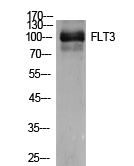FLT3 antibody
GTX10654
ApplicationsWestern Blot, ELISA, Neutralisation/Blocking
Product group Antibodies
ReactivityHuman
TargetFLT3
Overview
- SupplierGeneTex
- Product NameFLT3 antibody
- Delivery Days Customer9
- Application Supplier NoteWB: 0.1-0.2 microg/ml. ELISA: 0.5-1.0 microg/mL. *Optimal dilutions/concentrations should be determined by the researcher.Not tested in other applications.
- ApplicationsWestern Blot, ELISA, Neutralisation/Blocking
- CertificationResearch Use Only
- ClonalityPolyclonal
- ConjugateUnconjugated
- Gene ID2322
- Target nameFLT3
- Target descriptionfms related receptor tyrosine kinase 3
- Target synonymsCD135, FLK-2, FLK2, STK1, receptor-type tyrosine-protein kinase FLT3, CD135 antigen, FL cytokine receptor, fetal liver kinase 2, fms related tyrosine kinase 3, fms-like tyrosine kinase 3, growth factor receptor tyrosine kinase type III, stem cell tyrosine kinase 1
- HostGoat
- IsotypeIgG
- Protein IDP36888
- Protein NameReceptor-type tyrosine-protein kinase FLT3
- Scientific DescriptionFlt3/Flk2 Ligand (FL) is produced from a DNA sequence encoding amino acid residues 1 to 185 polypeptide of Flt3/Flk2 ligand. The 159 amino acid residue recombinant protein, generated after removal of the 26 amino acid residue signal peptide, has a predicted molecular mass of approximately 17.5 kDa. The gene for FL has been mapped to chromosomes 19q13.3 and 13q12-q13 in humans. The Flt3 (fms-like tyrosine kinase 3)/Flk2 (fetal liver kinase 2) Ligand (FL), a hematopoietic cytokine, was cloned based on its ability to bind and activate c-kit and Flt3 tyrosine kinase receptors. Fl plays a key role in hematopoiesis by stimulating proliferation and/or differentiation of various hematopoietic cell types in vitro as well as in vivo. Human FL, a type I transmembrane glycoprotein, is biologically active on the cell surface and can be cleaved to generate a soluble form that is also biologically active. Also, an alternatively spliced soluble isoform of FL has been identified in both human and mouse. Human and mouse FL share 72% amino acid sequence homology and exhibit full species cross-reactivity.FL has been shown to synergize with a wide variety of hematopoietic cytokines to stimulate the growth and differentiation of early hematopoietic progenitors. FL promotes growth of early B cell progenitor cells in combination with IL-7 and induces adhesion of the precursor B cell line Baflt3 to fibronectin by activating the fibronectin receptors VLA-4 and VLA-5 integrins. Flt3/Flk2 ligand is widely expressed in a variety of tissues. Cells known to express FL include T cell lines, a thymic stromal cell line 1, and bone marrow fibroblasts. In hematopoietic cells, the expression of Flt3/Flk2 is restricted to the population enriched for precursor/progenitor cells.
- ReactivityHuman
- Storage Instruction-20°C or -80°C,2°C to 8°C
- UNSPSC12352203




![WB analysis of Baf3 cells untreated or treated with FLT3 ligand using GTX36299 FLT3 (phospho Tyr969) antibody [T.602.6] (upper panel) or FLT3 antibody (lower panel).](https://www.genetex.com/upload/website/prouct_img/normal/GTX36299/GTX36299_1857_WB_w_23060819_603.webp)